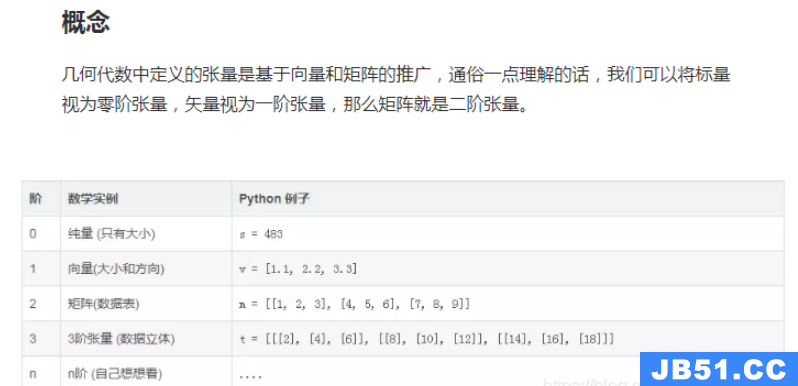程序 = 数据结构+算法。
TensorFlow程序 = 张量数据结构 + 计算图算法语言
张量和计算图是 TensorFlow的核心概念。
Tensorflow的基本数据结构是张量Tensor。张量即多维数组。Tensorflow的张量和numpy中的array很类似。
从行为特性来看,有两种类型的张量,常量constant和变量Variable.
常量的值在计算图中不可以被重新赋值,变量可以在计算图中用assign等算子重新赋值。
一,常量张量
张量的数据类型和numpy.array基本一一对应。
import numpy as np tensorflow as tf i = tf.constant(1) # tf.int32 类型常量 l = tf.constant(1,dtype = tf.int64) tf.int64 类型常量 f = tf.constant(1.23) tf.float32 类型常量 d = tf.constant(3.14,dtype = tf.double) tf.double 类型常量 s = tf.constant("hello world") tf.string类型常量 b = tf.constant(True) tf.bool类型常量 print(tf.int64 == np.int64) print(tf.bool == np.bool) print(tf.double == np.float64) print(tf.string == np.unicode) tf.string类型和np.unicode类型不等价
True True True False
不同类型的数据可以用不同维度(rank)的张量来表示。
标量为0维张量,向量为1维张量,矩阵为2维张量。
彩色图像有rgb三个通道,可以表示为3维张量。
视频还有时间维,可以表示为4维张量。
可以简单地总结为:有几层中括号,就是多少维的张量。
scalar = tf.constant(True) 标量,0维张量 print(tf.rank(scalar)) print(scalar.numpy().ndim) tf.rank的作用和numpy的ndim方法相同
<tf.Tensor: shape=(),dtype=int32,numpy=0>
0
vector = tf.constant([1.0,2.0,3.0,4.0]) 向量,1维张量 (tf.rank(vector)) print(np.ndim(vector.numpy()))
tf.Tensor(1,shape=(),dtype=int32)
1
matrix = tf.constant([[1.0,2.0],[3.0,4.0]]) 矩阵,2维张量 (tf.rank(matrix).numpy()) print(np.ndim(matrix))
2
2
tensor3 = tf.constant([[[1.0,4.0]],[[5.0,6.0],[7.0,8.0]]]) 3维张量 (tensor3) print(tf.rank(tensor3))
tf.Tensor( [[[1. 2.] [3. 4.]] [[5. 6.] [7. 8.]]],shape=(2,2,2),dtype=float32)
tf.Tensor(3,dtype=int32)
tensor4 = tf.constant([[[[1.0,1.0],[2.0,2.0]],[[3.0,3.0],[4.0,4.0]]],[[[5.0,5.0],[6.0,6.0]],[[7.0,7.0],[8.0,8.0]]]]) 4维张量 (tensor4) print(tf.rank(tensor4))
tf.Tensor( [[[[1. 1.] [2. 2.]] [[3. 3.] [4. 4.]]] [[[5. 5.] [6. 6.]] [[7. 7.] [8. 8.]]]],dtype=float32)
tf.Tensor(4,dtype=int32)
可以用tf.cast改变张量的数据类型。
可以用numpy方法将tensorflow中的张量转化成numpy中的张量。
可以用shape方法查看张量的尺寸。
h = tf.constant([123,456],dtype = tf.int32) f = tf.cast(h,tf.float32) (h.dtype,f.dtype) <dtype: 'int32'> <dtype: float32'>
y = tf.constant([[1.0,1)">]]) print(y.numpy()) 转换成np.array (y.shape) [[1. 2.] [3. 4.]] (2,2)
u = tf.constant(u你好 世界") (u.numpy()) print(u.numpy().decode(utf-8)) b\xe4\xbd\xa0\xe5\xa5\xbd \xe4\xb8\x96\xe7\x95\x8c' 你好 世界
二,变量张量
模型中需要被训练的参数一般被设置成变量。
常量值不可以改变,常量的重新赋值相当于创造新的内存空间 c = tf.constant([1.0,2.0]) (c) (id(c)) c = c + tf.constant([1.0,1.0print(id(c))
tf.Tensor([1. 2.], shape=(2,), dtype=float32)
5276289568
tf.Tensor([2. 3.], dtype=float32)
5276290240
变量的值可以改变,可以通过assign,assign_add等方法给变量重新赋值 v = tf.Variable([1.0,name = v(v) (id(v)) v.assign_add([1.0,1)">print(id(v))
<tf.Variable 'v:0' shape=(2,) dtype=float32, numpy=array([1., 2.], dtype=float32)>
5276259888
<tf.Variable 'v:0' shape=(2, numpy=array([2., 3.], dtype=float32)>
5276259888
参考:
开源电子书地址:https://lyhue1991.github.io/eat_tensorflow2_in_30_days/
GitHub 项目地址:https://github.com/lyhue1991/eat_tensorflow2_in_30_days

